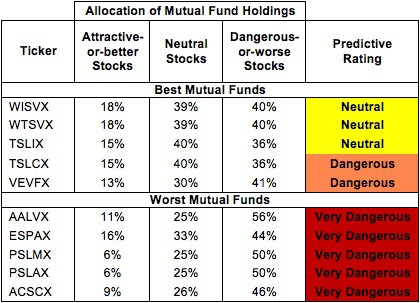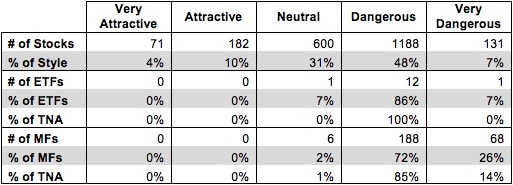The Small Cap Value style ranks twelfth out of the twelve fund styles as detailed in my Style Rankings for ETFs and Mutual Funds report. It gets my Dangerous rating, which is based on aggregation of ratings of 14 ETFs and 262 mutual funds in the Small Cap Value style as of July 19, 2013. Prior reports on the best & worst ETFs and mutual funds in every sector and style are here.
Figures 1 and 2 show the five best and worst-rated ETFs and mutual funds in the style.
Not all Small Cap Value style ETFs and mutual funds are created the same. The number of holdings varies widely (from 23 to 1618), which creates drastically different investment implications and ratings. The best ETFs and mutual funds allocate more value to Attractive-or-better-rated stocks than the worst, which allocate too much value to Neutral-or-worse-rated stocks.
To identify the best and avoid the worst ETFs and mutual funds within the Small Cap Value style, investors need a predictive rating based on (1) stocks ratings of the holdings and (2) the all-in expensesof each ETF and mutual fund. Investors need not rely on backward-looking ratings. My fund rating methodology is detailed here.
Investors should not buy any Small Cap Value ETFs or mutual funds because none get an Attractive-or-better rating. If you must have exposure to this style, you should buy a basket of Attractive-or-better rated stocks and avoid paying undeserved fund fees. Active management has a long history of not paying off.
Get my ratings on all ETFs and mutual funds in this style on my free mutual fund and ETF screener.
Figure 1: ETFs with the Best & Worst Ratings – Top 5
 * Best ETFs exclude ETFs with TNAs less than $100 million for inadequate liquidity.
* Best ETFs exclude ETFs with TNAs less than $100 million for inadequate liquidity.
Sources: New Constructs, LLC and company filings
iShares Enhanced U.S. Small Cap ETF (IESM) and First Trust Small Cap Value AlphaDEX Fund (FYT) are excluded from Figure 1 because each of their total net assets (TNA) are below $100 million and do not meet our liquidity standards.
Figure 2: Mutual Funds with the Best & Worst Ratings – Top 5
 * Best mutual funds exclude funds with TNAs less than $100 million for inadequate liquidity.
* Best mutual funds exclude funds with TNAs less than $100 million for inadequate liquidity.
Sources: New Constructs, LLC and company filings
5 Funds are excluded from Figure 2 because each of their total net assets (TNA) are below $100 million and do not meet our liquidity standards.
Vanguard Small Cap Value ETF (VBR) is my top-rated Small Cap Value ETF and Westcore Small Cap Value Dividend Fund (WISVX) is my top-rated Small Cap Value mutual fund. VBR gets my Dangerous rating, while WISVX gets my Neutral rating.
ProShares Ultra Russell 2000 Value (UVT) is my worst-rated Small Cap Value ETF and American Century Capital Small Cap Value Fund (ACSCX) is my worst-rated Small Cap Value mutual fund. Both earn my Very Dangerous rating.
Figure 3 shows that 253 out of the 2172 stocks (over 14% of the market value) in Small Cap Value ETFs and mutual funds get an Attractive-or-better rating. However, zero out of 14 Small Cap Value ETFs and zero out of 262 Small Cap Value mutual funds get an Attractive-or-better rating.
The takeaways are: mutual fund managers allocate too much capital to low-quality stocks and Small Cap Value ETFs hold poor quality stocks.
Figure 3: Small Cap Value Style Landscape For ETFs, Mutual Funds & Stocks
As detailed in “Low-Cost Funds Dupe Investors”, the fund industry offers many cheap funds but very few funds with high-quality stocks, or with what I call good portfolio management.
Investors need to tread carefully when considering Small Cap Value ETFs and mutual funds, as just a handful earn greater than a Dangerous rating. No ETFs or mutual funds in the Small Cap Value style allocate enough value to Attractive-or-better-rated stocks to earn an Attractive rating. Investors would be better off focusing on individual stocks instead.
Automated kiosk provider Outerwall Inc. (OUTR) is one of my favorite stocks held by Small Cap Value ETFs and mutual funds and earns my Attractive rating. Since 2002, OUTR has grown profits (NOPAT) by 27% compounded annually. OUTR’s return on invested capital (ROIC) of 17% also puts it in the top quintile of all the companies I cover. Much of this growth has been fueled by OUTR’s Redbox business, but this company is far from a one-trick pony. OUTR has recently made deals with Starbucks-owned Seattle’s Best to begin installing brand name coffee machines at its various locations. OUTR is also innovating with its new EcoATM, a machine that trades consumers’ used mobile devices for cash.
Even with OUTR’s excellent profit growth, the stock is trading at ~$63/share, which gives it a price to economic book value ratio of 0.9. This ratio implies that the market expects OUTR’s profits to decline by 10% and never recover. This decline seems unlikely, especially considering OUTR’s new diversified businesses. OUTR is trading at a discount and investors should take advantage.
Zions Bancorporation (ZION) is one of my least favorite stocks held by Small Cap Value ETFs and mutual funds and earns my Dangerous rating. ZION’s profits (NOPAT) have fallen by 4% compounded annually since 2001, and its ROIC of just 2% puts it in the bottom quintile of all companies I cover. ZION has also earned negative economic earnings since the beginning of my model. This underperformance seems to have not affected the market’s expectations, however, as ZION is currently trading at ~$30/share. To justify its stock price, ZION would need to grow NOPAT by 14% compounded annually for 11 years. These expectations are lofty for any business, and ZION’s decline in profits should give investors cause to doubt that it will be able to meet the market’s expectations. ZION is too expensive for its weak fundamentals, and investors should avoid this stock.
Figures 4 and 5 show the rating landscape of all Small Cap Value ETFs and mutual funds.
My Style Rankings for ETFs and Mutual Funds report ranks all styles and highlights those that offer the best investments.
Figure 4: Separating the Best ETFs From the Worst Funds
 Sources: New Constructs, LLC and company filings
Sources: New Constructs, LLC and company filings
Figure 5: Separating the Best Mutual Funds From the Worst Funds
Review my full list of ratings and rankings along with reports on all 14 ETFs and 262 mutual funds in the Small Cap Value style.
André Rouillard contributed to this report.
Disclosure: David Trainer and André Rouillard receive no compensation to write about any specific stock, sector, style or theme.


